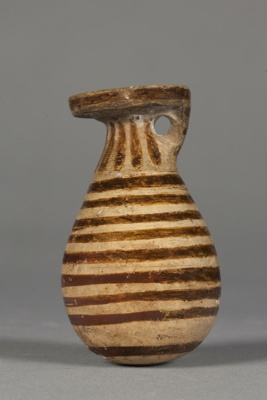< Collection search
< Collection highlights
From:UC Teece Museum of Classical Antiquities
Name/TitleAlabastron
About this objectThe alabastron takes its name from the stone alabaster, which was commonly used in Egypt to make these small perfume vials. The somewhat cylindrical, rounded shape was designed to be easily held and carried in one hand. The small lug-handle is pierced to allow a strap to be looped through which could be tied around the wrist or neck to keep hands free.
Made of pale, buff clay, the decoration on this alabastron is simple yet effective. The horizontal bands emphasise the curve of the body and the rounded base, and the tongues radiating out from the neck add contrast to extend the shape. The circular bands are continued on the upper face of the disc-like mouth, which is a similar shape to an aryballos. This style of mouth with a narrow opening makes it easier to control the flow of perfume or oil from the vase and can help protect from spilling while being carried.
Date MadeEarly 6th Century BCE
PeriodArchaic
Place MadeItaly
Place NotesEtruria
Medium and MaterialsCeramic: Pottery
Style and IconographyEtruscan
Style and IconographyOrientalising
TechniqueThrowing (pottery technique)
TechniqueGlazing (coating process)
MeasurementsHeight 75mm; Diameter 44mm
Subject and Association KeywordsCosmetics
Subject and Association KeywordsSocial life and customs
Named CollectionThe James Logie Memorial Collection, University of Canterbury, New Zealand
Credit LineDonated by Mrs Broadhead, 1968. From the collection of Professor H.D. Broadhead.
Object TypeContainers
Object number77.68
Copyright LicenceAll rights reserved
